Ivy and Trees – A Common Sight in Chapel Hill, Durham, and Hillsborough
Stroll through the streets of Chapel Hill, wander in the parks of Durham, or explore the historic districts of Hillsborough, and you’ll notice a recurring natural tapestry: trees elegantly cloaked in ivy. This embrace, where nature seems to intertwine with itself, is not just a visual treat for those who live in or visit these areas but also a topic that invites curiosity and ecological consideration.
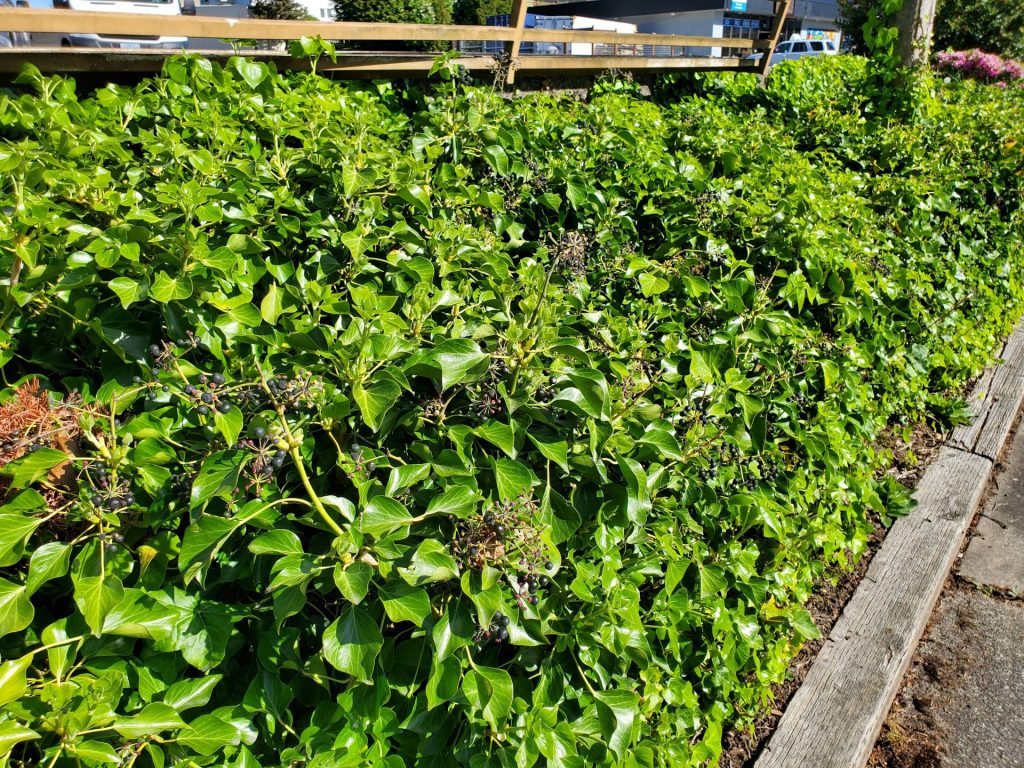
In Chapel Hill, ivy adorns the historic buildings and ancient trees, adding a touch of academia and age-old beauty to the landscape. Move over to Durham, and you’ll find ivy contributing to the urban greenery, creating a juxtaposition of nature against the city’s modern backdrop. Hillsborough, with its rich historical tapestry, sees ivy as a link to the past, with its tendrils creeping over landmarks and old stone walls.
But what does this mean for the health and well-being of our trees? Does ivy serve as a friend or a foe to the bark it climbs? This question becomes particularly pertinent in regions like ours, where the interplay of nature and urban development is constant. The relationship between ivy and trees is not black and white; it’s a complex interaction that varies with the type of ivy, the species of tree, and the specific environmental conditions.
Understanding this ivy-tree dynamic is more than an academic exercise; it’s about maintaining the health and beauty of our neighborhoods. It’s about preserving the charm of Chapel Hill’s collegiate atmosphere, the vibrant urban life of Durham, and the historical allure of Hillsborough.
In the following sections, we’ll dive into the world of ivy – identifying the common types that grace our area, discussing their growth habits, and exploring their impact on the trees they inhabit. Whether you’re a homeowner wondering about the ivy climbing your backyard tree, a nature enthusiast curious about local flora, or someone who appreciates the greenery that adorns our communities, this exploration will provide insights into the intricate relationship between ivy and trees in our beloved Chapel Hill, Durham, and Hillsborough.
What is Ivy? Unraveling the Climber Vines
When you look at the lush, green ivy that clings to the trees in our neighborhoods, you’re witnessing more than just a quaint feature of our local landscapes. This section will delve into the scientific aspects of common ivy types in Chapel Hill, Durham, and Hillsborough, exploring their characteristics and growth habits, with insights drawn from reputable university research.
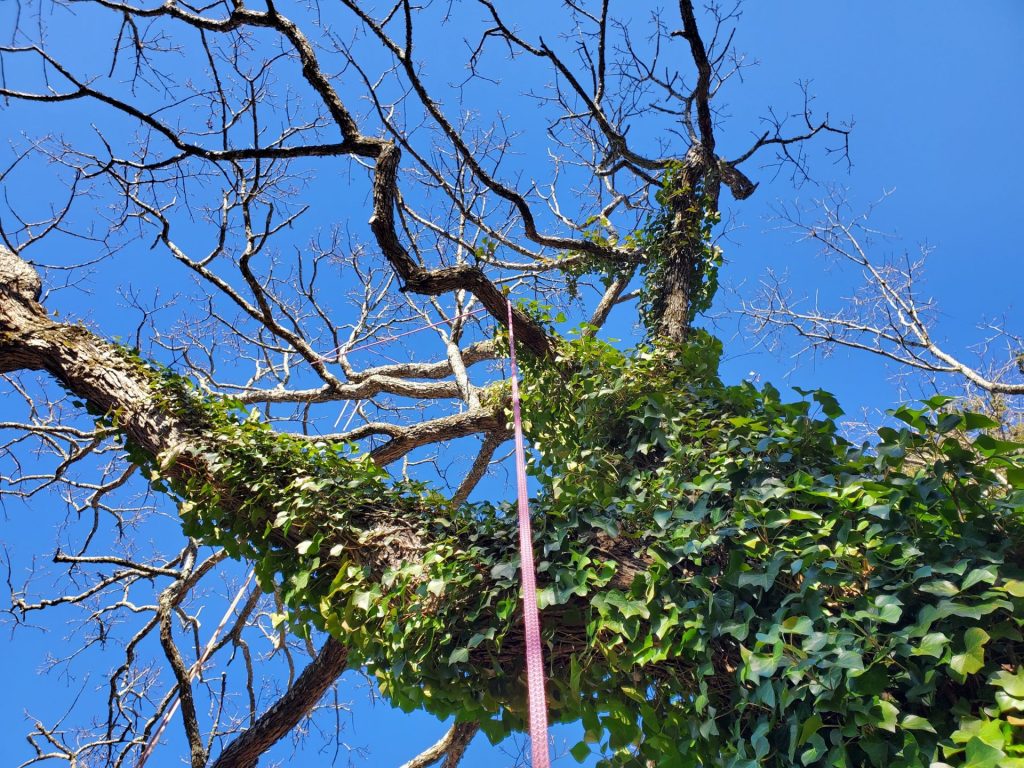
Common Ivy Types and Their Scientific Insights
- English Ivy (Hedera helix): Dominating the scenes in Chapel Hill, English Ivy is a perennial vine known for its damaging impact on trees. Its heavy vines can lead to fungal diseases and decay in mature trees, and it serves as a host for bacterial leaf scorch affecting maples, oaks, and elms (Source: University of Maryland Extension).
- Irish Ivy (Hedera hibernica): A close relative of English Ivy, Irish Ivy in Durham shares many ecological impacts. Its growth can cause similar problems for local trees, necessitating careful management to protect the urban greenery.
- Boston Ivy (Parthenocissus tricuspidata): While not a true ivy, Boston Ivy, popular in Hillsborough, poses less risk to tree health. It uses tendrils for climbing and is favored for its less aggressive nature and stunning fall colors.
Growth Habits and Ecological Impact
- Reproductive Traits: English Ivy reproduces via seed and vegetative spread, quickly colonizing areas and climbing trees. This adaptability makes it a formidable presence in various landscapes (Penn State Extension).
- Climbing and Coverage: English Ivy’s dense foliage can smother tree limbs, blocking sunlight and inhibiting photosynthesis, a significant concern in tree-rich areas like Durham (Clemson Cooperative Extension).
- Environmental Considerations: When left unmanaged, English Ivy can invade woodlands and climb trees, leading to their decline and death. This invasive nature poses a threat to both natural and built environments, which is a critical issue in urban landscapes like Chapel Hill and Durham (NC State Extension).
This scientific exploration of ivy, particularly the types found in our area, underscores the importance of responsible management to ensure these plants do not harm the trees and structures they adorn. While they add character and charm, their impact on local ecosystems must be carefully considered.
Is Ivy Growth Acceptable on Trees in Our Region?
The question of whether ivy growth is suitable for trees in areas like Chapel Hill, Durham, and Hillsborough is complex, as it involves balancing the ecological impacts with aesthetic and practical considerations.
Analyzing Ivy’s Suitability for Local Trees
- Ecological Impact: In the US, particularly in regions like ours, the majority of ivy, such as English or Irish ivy, is not native. These ivies can cause problems for local trees, which are not accustomed to ivy. Issues include reducing tree stability, adding weight and wind resistance, and potentially smothering the tree’s foliage. This is especially true for English Ivy (Hedera helix), which has been labeled as an invasive species in many parts of the country. It can encircle trees, impede photosynthesis by blocking sunlight, and create hazards due to its weight, particularly when laden with snow or ice (University of Maryland Extension; OSU Extension Service).
- Aesthetic and Practical Considerations: Despite its ecological impacts, ivy has long been appreciated for its aesthetic qualities. It adds year-round greenery, even when trees lose their leaves, and has been a part of cultural and artistic motifs. In controlled environments, it can be visually appealing and provide benefits such as habitat and food for wildlife, including nectar for insects and berries for birds. However, these benefits are overshadowed by the potential harm ivy can cause to trees and ecosystems (Rock Tree Surgeons).
Circumstances Where Ivy Might Be Harmless
- In situations where ivy growth is carefully managed and pruned, it may coexist with trees without causing significant harm.
- Young, robust trees in well-maintained landscapes might tolerate some level of ivy growth without immediate negative effects.
- Ivy growing on structures or in areas where it doesn’t threaten tree health can be aesthetically pleasing and beneficial for wildlife.
Is Ivy Invasive to Trees in Our Region?
In examining the invasiveness of ivy, particularly in regions like Chapel Hill, Durham, and Hillsborough, it’s crucial to understand the extent to which ivy can impact local trees and ecosystems.
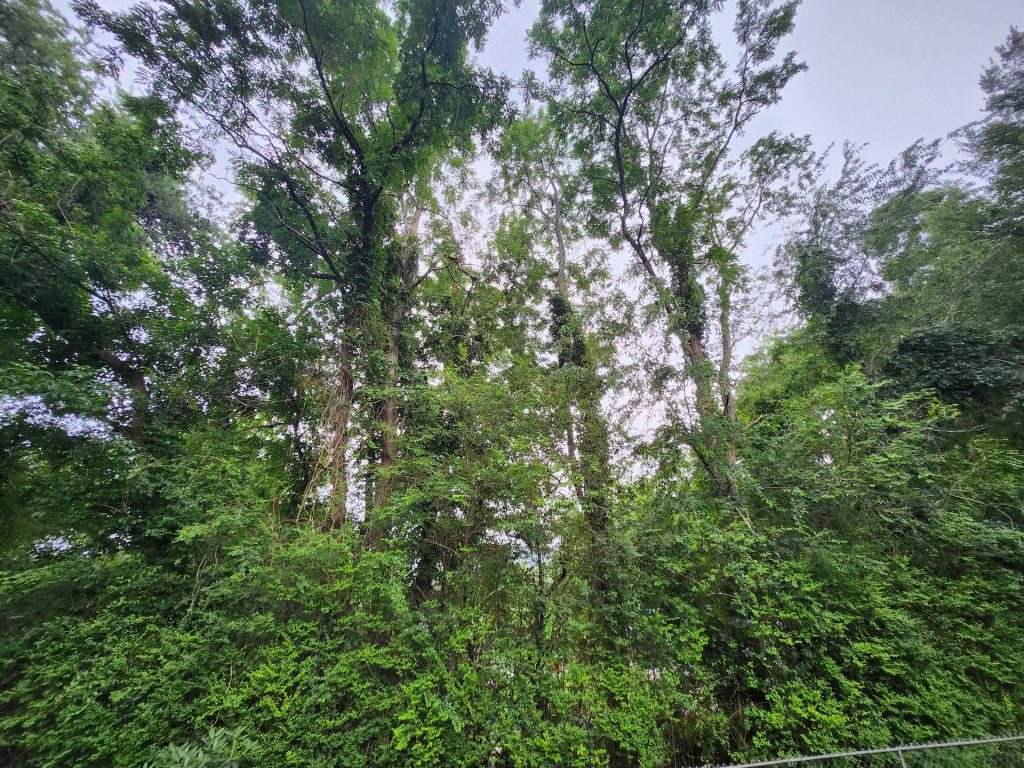
The Invasive Nature of Ivy
- Ecological Threat: English ivy, a non-native species in the US, poses a significant threat to various habitats. It forms dense monocultures on the ground, suppressing native seedlings and herbs, and as a vine, it can engulf and ultimately kill shrubs and trees. Its ability to form a thick canopy over trees and shrubs means that light cannot reach the leaves of the host plant, weakening it and making it more susceptible to disease and blowdown. This characteristic makes it especially invasive along the eastern seaboard, including areas like North Carolina (University of Maryland Extension).
- Impact on Tree Health: On trees, ivy can cause severe damage. It engulfs branches, shading and slowly killing them. The added weight of ivy, particularly during adverse weather conditions like wind, snow, or ice, can topple trees. Moreover, ivy is a reservoir for bacterial leaf scorch, a serious disease that affects various tree species, including maples, oaks, and elms. This poses a risk to the diverse tree species prevalent in our region (University of Maryland Extension).
- Propagation and Spread: Ivy’s rapid growth and hardiness make it an invasive threat. It spreads both as a groundcover and as a climbing vine, often completely engulfing structures and trees. Once it begins to climb, it can produce flowers and berries, which are spread by birds, furthering its reach. This invasive nature of ivy, coupled with its ability to spread through seeds and vegetative runners, makes it a significant concern in landscapes (N.C. Cooperative Extension; OSU Extension Service).
Rescuing Trees from Ivy
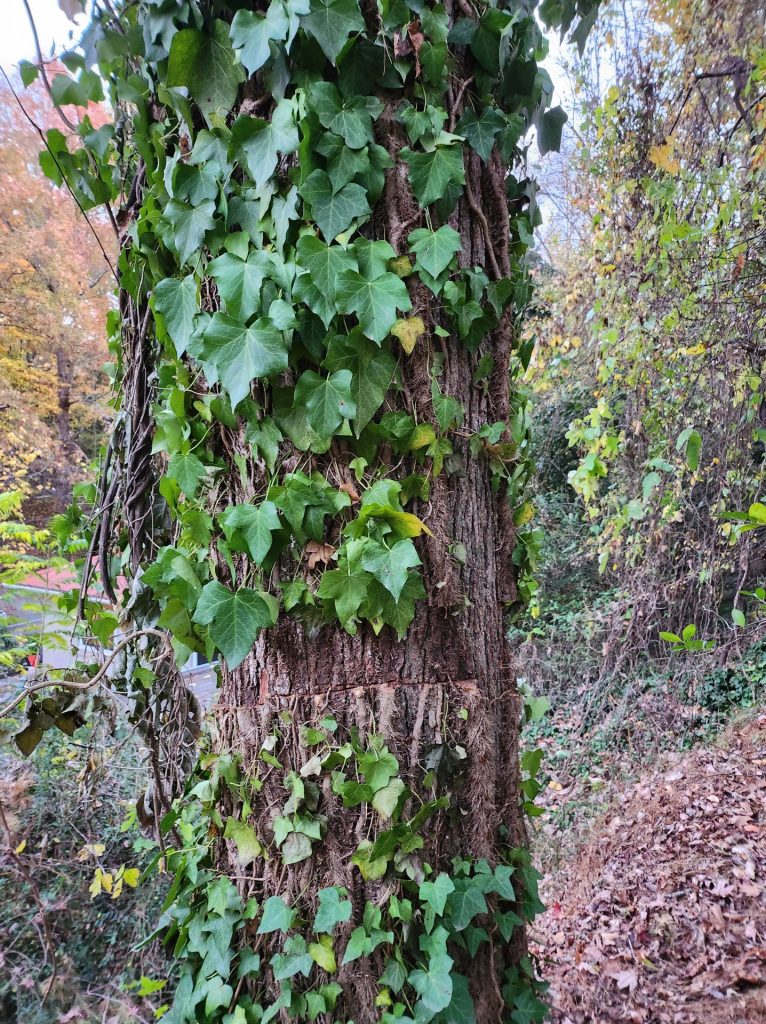
Strategies for Safely Removing Ivy
- Mowing for Control: Repeated mowing can be effective against English ivy, especially for ground cover. By continuously cutting back the new leaves, the ivy’s root energy stores are gradually depleted, hindering its growth (Piedmont Master Gardeners).
- Manual Removal: Hand pulling is the primary method for manual ivy removal, especially to avoid chemical use. For larger ivy removal projects, it’s advised to first create ivy-free zones around tree bases to prevent trees from being overgrown. Prioritize removing flowering or fruiting ivy and dispose of it properly to prevent resprouting (OSU Extension Service).
Tips for Ivy Removal
- Life Saver Method: This technique involves creating a 3–5 feet ivy-free circle around the tree trunk, offering relief to the tree while complete ivy removal is in progress. The method includes cutting ivy vines around the tree, peeling them away from the bark, and then removing the ivy from the ground (OSU Extension Service).
- Herbicide Use: While herbicide sprays are generally ineffective on mature ivy due to their waxy leaves, they can be effective on immature leaves. Spot application of herbicides like glyphosate can be useful after manual removal for tidying up regrowth. For larger roots that can’t be pulled out, concentrated herbicides can be directly applied (Piedmont Master Gardeners).
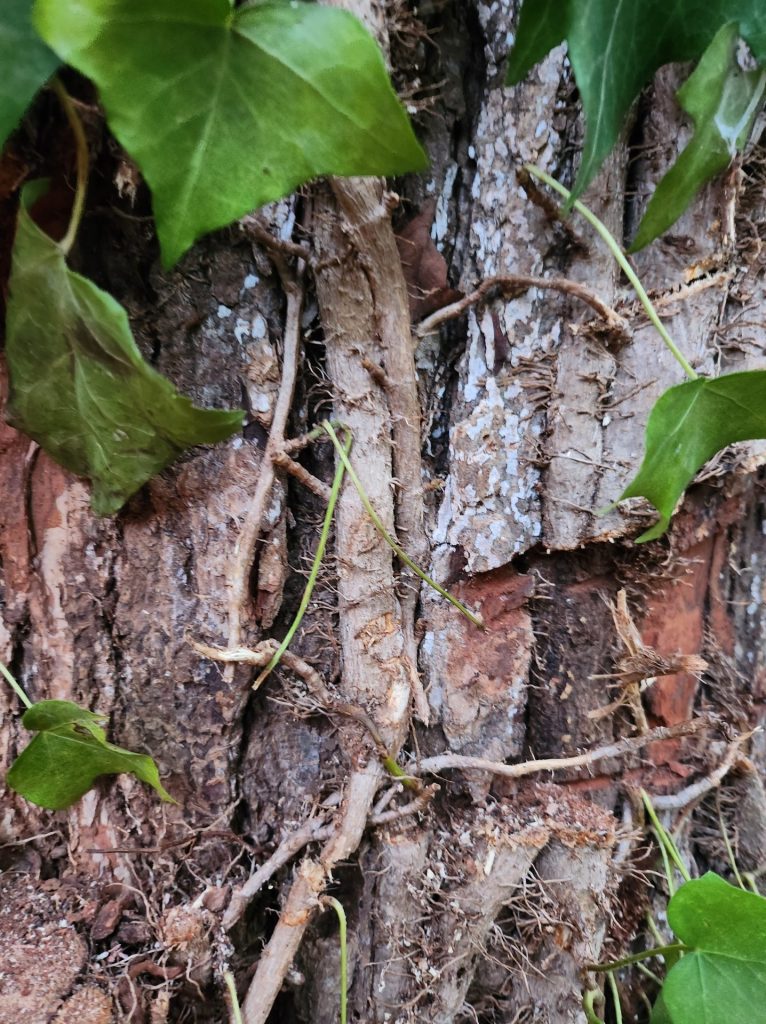
When to Seek Professional Tree Services
- Extensive Infestations: For large-scale ivy infestations, especially those impacting trees or structures, professional services is recommended. We can effectively manage the ivy, preventing it from causing structural damage and improving the longevity of affected areas.
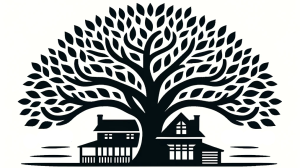
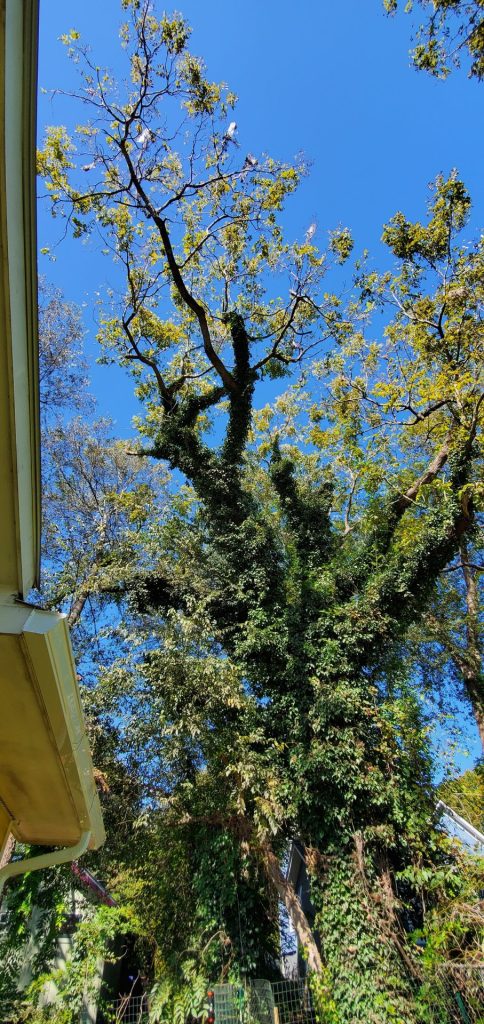
Leave a Reply